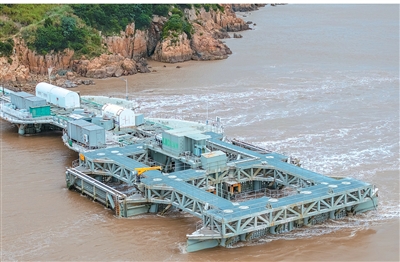




- BRNN
- BRI News
- BRNN News
- Database
Official Documents Polices and Regulations
Inter-government Documents International Cooperation BRI Countries
Business Guide Economic Data BRI Data
Trade
Investment Projects Latest projects
Cases - Content Pool

Photo shows the LHD-developed tidal energy generating unit on Xiushan Island, Daishan county, Zhoushan city, east China's Zhejiang Province. (Photo courtesy of the interviewee)
Off the coast of Xiushan Island in Daishan county, Zhoushan city, east China's Zhejiang Province, the LHD tidal current power station now ranks among the world's leaders in its continuous grid-connected operation time.
Inside the marine energy laboratory of LHD, a company based in the provincial capital Hangzhou, a large monitoring screen displays real-time footage of the station's power generation.
"Tides follow a precise schedule. We can calculate their movements well in advance," said Lin Dong, director and chief engineer of the Zhejiang LHD Ocean Tidal Current Energy Engineering Research Center.
At LHD, dozens of invention patents line the exhibition hall walls, documenting years of painstaking research into tidal power technology.
"Conditions were tough at the start. We conducted experiments in a swimming pool, with a few people manually dragging equipment to create artificial currents," Lin said, recalling the early days of their research.
Lin and his team finally developed and validated a "platform-based and modular" approach to harnessing tidal energy, overcoming the technical challenges of sustainably integrating high-power tidal generators into the power grid.

Photo shows a panoramic view of the LHD tidal current power station on Xiushan Island, Daishan county, Zhoushan city, east China's Zhejiang Province. (Photo courtesy of the interviewee)
In July 2016, the first-generation LHD tidal current energy generator successfully went into operation. The following month, the first unit began generating power and was connected to the grid, making China one of few countries capable of developing megawatt-scale grid-connected tidal projects.
The fourth-generation tidal current energy turbine, Endeavor, China's first megawatt-class unit, was launched in February 2022. After trial operations, it was connected to the grid, signaling that China reached the megawatt-level milestone in tidal power.
As of late October this year, the LHD tidal current energy project had accumulatively generated over 8.34 million kilowatt-hours of electricity, maintaining global leadership in both unit capacity and continuous operation time. This output is equivalent to saving about 2,359 tonnes of standard coal, contributing significantly to China's dual carbon goals.
In February, six government departments, including the Ministry of Natural Resources and the National Development and Reform Commission, jointly issued guidelines to promote large-scale marine energy utilization. The plan called for implementing hundred-megawatt-class tidal power projects in resource-rich areas, positioning tidal power generation as a key green energy solution for coastal regions and islands.
To date, multiple tidal power demonstration projects have been established in Zhoushan.
In September, a 100-megawatt tidal power project jointly invested in by the State Power Investment Corporation Zhejiang Branch and LHD was officially launched in Zhoushan. The project has completed its signing, and construction will begin soon.
"Given Zhoushan's abundant tidal energy resources, leading tidal power technology in the country, and deep-water coastline suitable for equipment export, the city plans to build a globally influential marine tidal energy hub," said Zheng Xuejun, director of Zhoushan's development and reform commission.
Data show that since the beginning of this year, the LHD project has fed over 1.61 million kilowatt-hours into the grid.

Tel:86-10-65363107, 86-10-65368220, 86-10-65363106